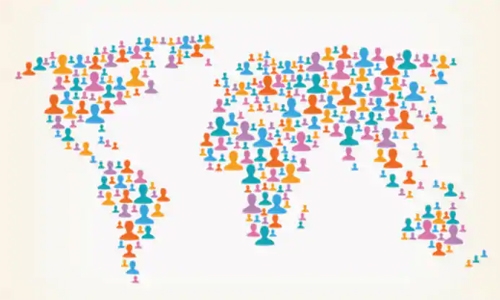Population clock is ticking
Bahrain’s population is projected to remain fairly stable over the next few decades, according to world population review, which also states that it will continue its steady 1 per cent annual growth rate. The data also means that by 2030, Bahrain will have 2,013,416 citizens with 63.92 per cent of it being males and 36.08pc being females, an increase of more than 22 per cent from 2019. The Kingdom’s population, according to the latest United Nations Estimate as on 1 July 2019, is 1,641,172, also making it 152nd in the world in terms of most populated countries.
The number is also equivalent to 0.02pc of the total world popula- tion which is 7,718,372,348 a n d ticking. Factors driving the change, albeit slowing, can be attributed to several scenarios including natural change, net migration and increasing life expectancy. The review states that one net migrant is arriving in every 13 minutes to the Kingdom or 113 net migrations per day citing the population clock based on the United Nations’ World Population Prospects 2019 data.
The data also says that there are 60 birth and 11 death per day in the Kingdom. Spotlight is thus on emigration for the key role it plays, which also means that Bahrain is on the list of World nations with lowest unemployment rate of 3.8pc according to The World Factbook, Central Intelligence Agency.
600,857 foreign workers in Q2, 2018
According to the Labour Market Regulatory Authority, there were 600,857 foreign workers in the kingdom by the end of the second quarter of 2018. This, however, was a decline of 0.9pc annually when compared to 606,357 workers in the same quarter of 2017. The decrease is a result of cleansing more than 13,000 domestic workers r e c o r d s during the s e c o n d quarter of 2018.
During the same period, the number of new regular employment work permits issued by LMRA was 39,566 showing an annual increase of 18.1pc. The share of small organisations, employing less than 10 workers, of regular work permits was 50.5pc of total permits issued during the second quarter of 2018.
Another interesting fact is that Asians, according to reports, will make up nearly half of the country’s residents in the upcoming period.
53pc by 2030
Thanks to the increasing number of foreign workforce, according to Arabian Business, Asian living in Bahrain overtook the population here for the first time in 2010. The gap is expected to grow up to 2030. The percentage of foreign citizens is expected to rise to 53pc by 2030, with the report attributing most of the increase to workers from South and Southeast Asia. Bahrain’s population, the report terms, is predominantly urban, with both the urban and rural populations are expected to experience significant growth up to 2030.
Urban population amounted to 88.9pc of the total population in 2017. Thus, the size of the population will certainly rise over the next few decades. On a global scale, according to the UN, an addition 2 billion people will be added between 2019 and 2050, with 1.05 billion (52pc) could be added in the countries of sub-Saharan Africa. Western Asian countries which include Bahrain, however, is projected to have a slower population growth rate.
On the United Nations, Human Development Indices and Indicators report, Bahrain is positioned 43 out of 189 countries and territories in the very high human development category. In comparison, the United Arab Emirates is ranked 49 on this index. Bahrain, according to the report, between 1990 and 2017 showed an increase of 13.4 per cent from HD value of 0.746 to 0.846. Life expectancy at birth during that period increased by 4.6 years.
The UN report also points out that the Kingdom’s 2017 HDI, an average measure of basic human development achievements in a country, of 0.846 is above the average of 0.699 of countries in the Arab States. Female participation in the labour market is 44.0pc compared to 87.0 for men.
Related Posts

